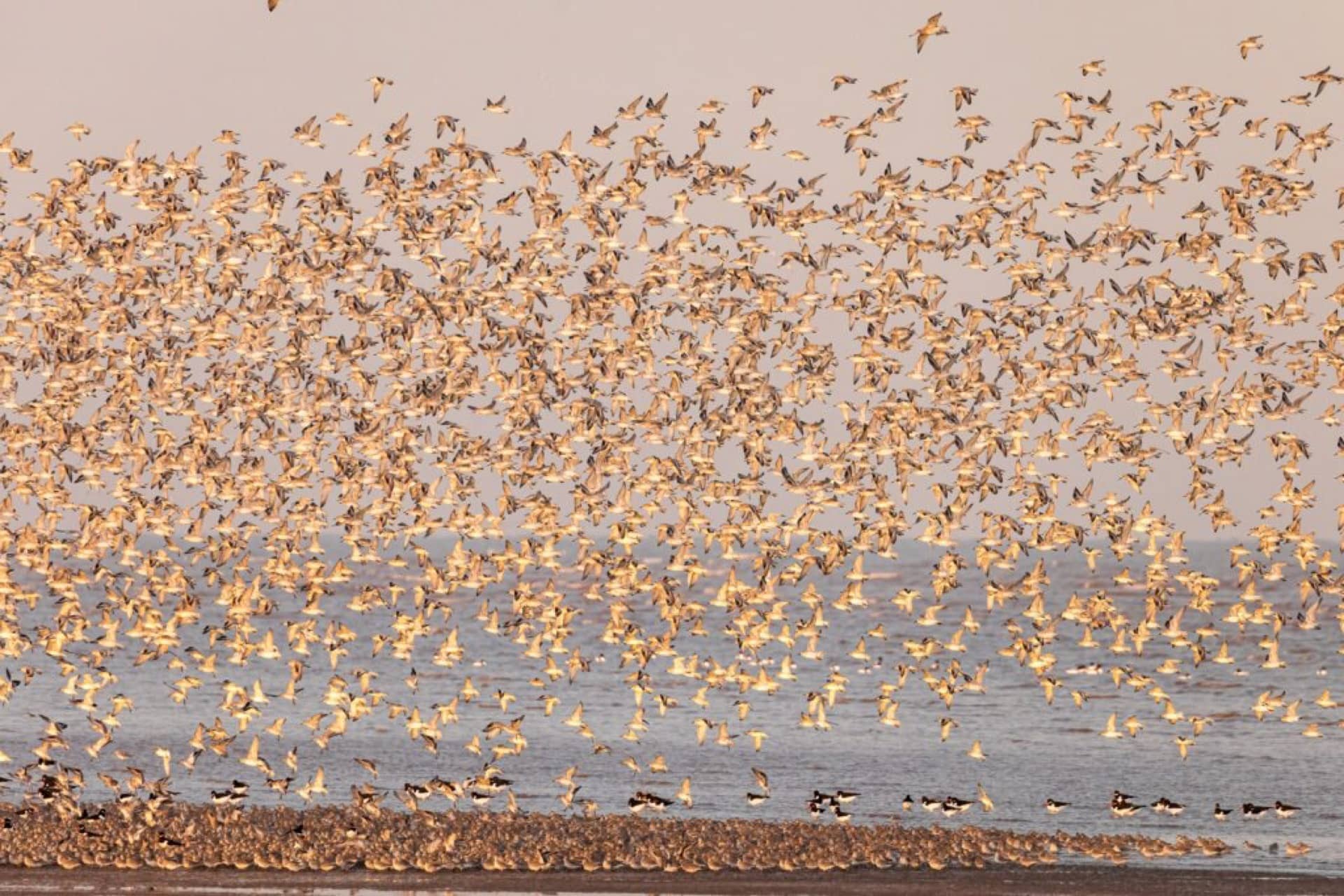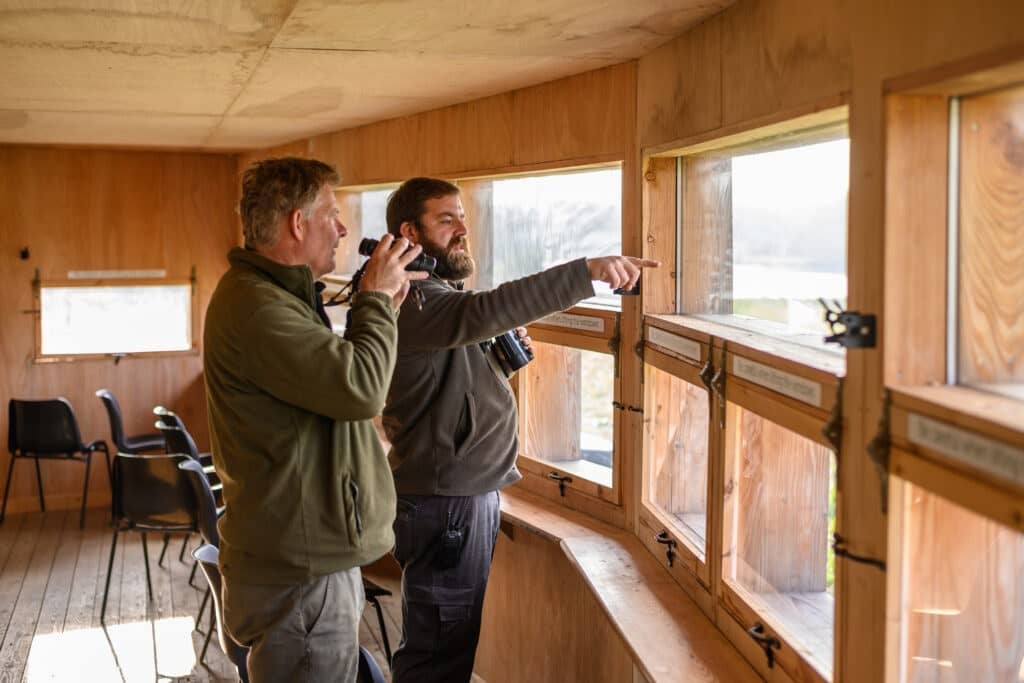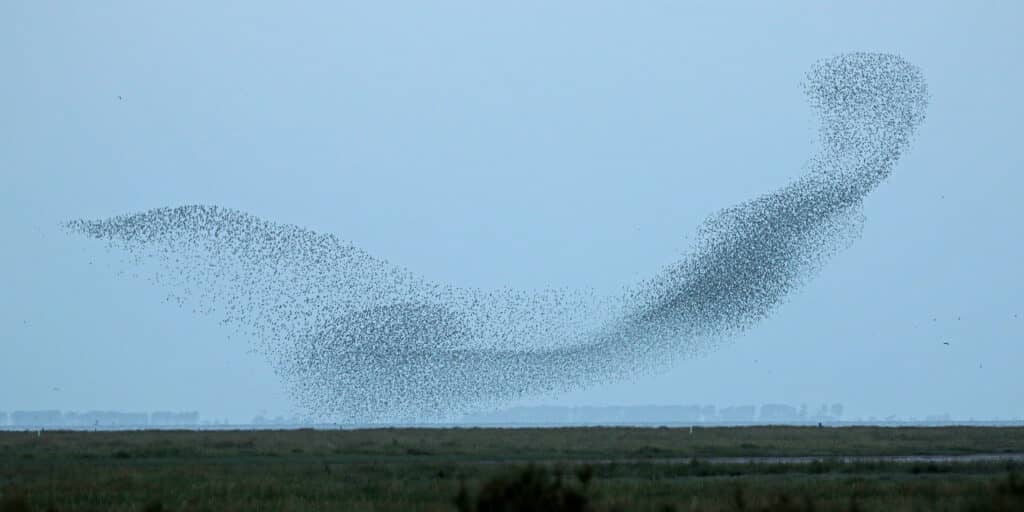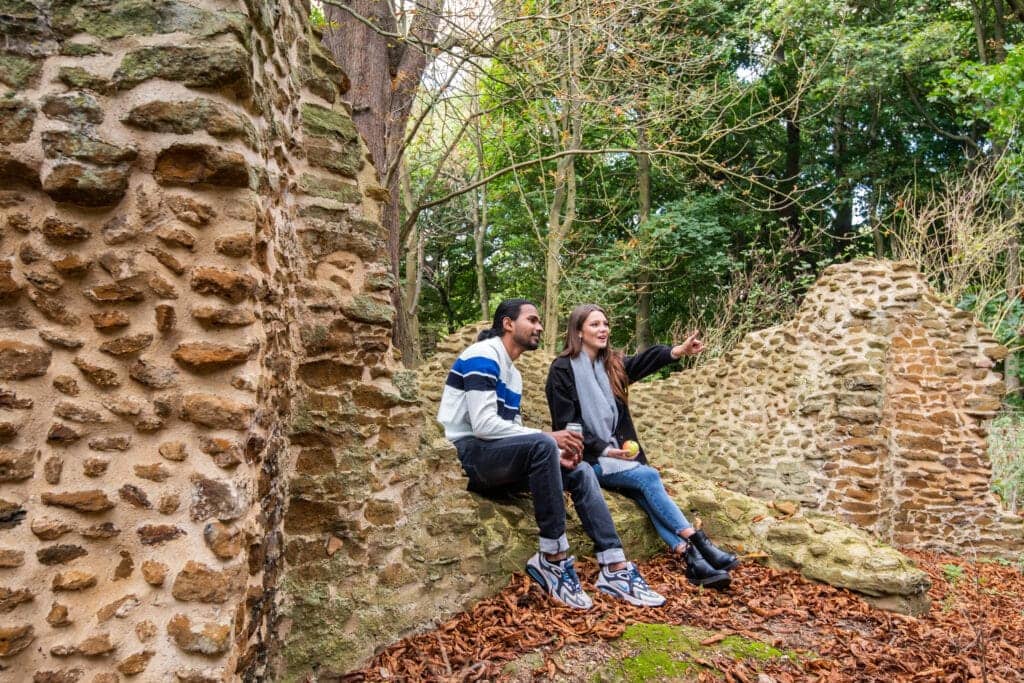
A Storm of Birds
Visit to Snettisham RSPB Nature Reserve – see unique natural spectacle of thousands of birds in flight on the highest tide of the year.
High tide roosts are a natural spectacle that reach their peak on spring high tides. Although the spectacle still happens outside of the highest tide and the geese are consistent during the Autumn and winter months.
At RSPB Snettisham, the highest tides give rise to an astonishing phenomenon. A natural wonder of the world, these epic aerial displays happen just a few times a year and are never the same twice.
This a wild, liminal land of lagoons, tidal mudflats, shingle beach and saltmarsh. Part of the wider Wash, it’s a refuge for many thousands of wildfowl and wading birds including Red Knot, Dunlin, Plovers, Oystercatchers and Bar-tailed Godwits who stalk the mud hunting for shellfish and worms. During the highest tides, known as Spring or King Tides, salt water completely covers the mud. Only then will these thousands of birds take to the air in a fluid symphony of sound and movement. This extraordinary winged ballet is choreographed by instinct, season and weather.
Because Spring Tides are rare, it’s essential to check the date and time before your trip.
If you can’t make a high tide, how about a frosty sunrise? Winter is the season of pink-footed geese, arriving in their thousands from summer breeding grounds in Iceland. Roosting on The Wash mudflats, vast skeins of beating wings fill the skies at first light as they fly inland to feast on sugar beet fields. On icy mornings, it’s tempting to stay tucked up in bed, but witnessing the haunting calls of wild geese at first light is one of life’s most exhilarating and unforgettable experiences. Truly a Norfolk spectacle not to be missed.

Inclusive Coastal Nature at RSPB Titchwell
Norfolk is one of the best places in England for winter birding. Nowhere matches this stunning county for variety of migrating birds, vast numbers of wintering wildfowl and rare sightings. RSPB Titchwell contains most of Norfolk’s magnificent coastal nature in one place, from graceful avocets and majestic marsh harriers to booming bitterns and bearded tits ‘pinging’ from the reeds. Titchwell is accessible if you can’t manage uneven or muddy tracks, wheelchair friendly hard paths take you from open fields to the coastal foreshore via reedbeds, marshes, lagoons and beach.
The haunting cry of geese fills the winter air, echoing across silver skies while the marshes ring with the whistles of wigeon and teal. You might even see elusive otters or busy water voles. It’s a place of constant change, fascinating all year round.
Head through woodland from the car park towards the visitor centre. A steaming coffee will warm you on your way through new worlds of discovery! Follow the boardwalk to explore the marshy woodland carr at the edge of the reedbeds, then head to the main path where reedbeds give way to freshwater lagoons full of sound and movement. Shelter in accessible hides to watch birds dip feeding over the water. Then pass brackish lagoons to tidal mudflats and a sweeping expanse of sand, sea and sky. Listen for the calls of oystercatcher, dunlin, or curlew. Immersed in nature’s wild winter, it feels like you’re on the edge of the world. And then, head back for cake!

Bird Watching in Stiffkey Wood
The small North Norfolk coastal village of Stiffkey nestles between saltmarsh and deep river valley, reminiscent of Devon. A narrow band of woodland clings to the last vestiges of dry land before the saltmarsh stretches towards the sea. Stunted and aged by winter gales and salty winds the trees are battered, facing northerly lands. They are often the first landfall Norfolk’s world famous bird migrations in Spring and Autumn, when yellow browed warblers, shrikes and firecrests, blow in on winds from the east and north. Other species, like the woodcock, wait until the right moon. Author Henry Williamson lived in the village and wrote about the woodcock’s annual arrival to Stiffkey Wood.
‘It would be pleasant to be a bird-watcher for a year: to wander thoughtless through the calm sequent days of summer’s ending: mist at morning: pallid disc of sun: windless heat and light of pale blue heaven and yellow line of sand dimming to the small red smoulder of sunset: the strings of tired birds, arriving over the sea, and settling at once on the marshes and in the low sand-dunes.
Day after day of windless calm and of sunlight, serene and warm, as though all life were suspended on earth, save for the movement of wave and tide, the piping and passing of birds. The early autumnal days were the most beautiful for that soon the sea would be black, with white lines on shoal and sandbank, while the tractor driver on the hills fastened the sack closer round his waist, against the bitter winds. Soon through the mists would float the woodcock moon, pale and circular; and with the north-east wind would come those strange birds, with dead-leaf mottle plumage and long beaks and gentle brown eyes, flapping across the North Sea, from the forests of Norway, and the stone walls of cold fields above fiords in whose green, glissading depths great salmon moved to their spawning beds.
Soon the wind would arise, and the woodcock flights over the sea begin. Singly and twos and threes, while the moon moved up the sky wind-burnished and bright, with purple shine about its winter beginning, the woodcock would come darkly over the waves.’

Discover Bird Watching
You may put out peanuts for perky little blue tits in your garden but could you tell a marsh tit from a coal tit? This half day course at Pensthorpe is for novice birdwatchers, curious about how to identify birds and, even if they’re hidden, know them by their song.
Pensthorpe’s spectacular diversity of habitats from lakes, ponds and rivers to woodlands, farmland and wildflower meadows means there’s always a fantastic mix of birds on the reserve. No wonder it’s been a popular filming location for BBC Springwatch! You may see winter visitors like skeins of pink-footed geese or busy fieldfare and redwing, just flown in from Scandinavia to feast on berries in the Norfolk hedgerows. Perhaps you’ll spot a red kite high above or hear a kingfisher as it darts by in a flash of turquoise.
When nature writer Melissa Harrison learned to recognise birds, she wrote in The Stubborn Light of Things, ‘more and more species swam out of anonymity into sharp focus…my brain no longer relegates bird calls to background noise. This is a change anyone can make.’ Once you know how to tune in, the instruments of the avian orchestra become distinct, a rich, layered tapestry of sound. The species you’ll see changes by season so if you fall in love with birdwatching, annual memberships are a great gift. At Pensthorpe, arrive as a beginner and leave as a birding expert. It’s never too late – or too early – to start.

RSPB Exclusive Bird Spectacular
Join the RSPB for an exclusive bird spectacular at their Snettisham reserve with panoramic views over shining mudflats and salty lagoons. Without question, this is one of the most memorable and enthralling natural events to be seen anywhere in Britain! Witness the noise, chaos and wild drama of the whirling waders as the sky roars to the exhilarating sound of ten thousand wingbeats.
Take your place at the Wader Watch point or in the Shore hide for this exclusive Snettisham experience and watch all the action in the company of an experienced and knowledgeable guide. When the birds have taken flight and the Wash falls quiet, you’ll spend time with your guide looking for other shorebirds and gulls feeding on the mudflats or resting in the saline lagoons. During the morning you’ll have a chance to learn more about these dynamic birds, their breeding and migration behaviours and why The Wash is such a unique and special eco-system. Finish the tour at Knots Landing, a new hide opened by Chris Packham, and watch bird action in the pits.
This event coincides with one of the highest spring tides of the year and public parking is always very limited. Your VIP ticket will guarantee you premium parking for this ever popular occasion, as well as the opportunity to spend the morning with an RSPB ranger.
To see the birds up close bring binoculars or a scope. And remember to bring your camera to capture the sheer thrill of nature’s magnificence.

Walk on the Wild Side: Ken Hill
A good walk on a cold, bright day does wonders for wellbeing, restoring the joy of connecting with nature. And you can always follow it with a hearty pub lunch! Start at the Snettisham Wood car park (PE31 7PF). Face west towards the sea and follow the left hand path along the edge of the woods past the old railway crossing house. Slender young oaks, birches with bark like white paper and chestnut trees grow alongside the uneven path which gradually ascends the hill. Walk deeper into the resting wood where trees are taller and older, many first rooted centuries ago. Gnarled branches of oak and beech form a living canopy until, west of the path, the view opens to rolling fields and a stunning vista towards the Wash. On clear days the wooded ridge of Sandringham can be seen. Walk round the edge of the wood, still sheltered by its ancient branches.
Listen for the plaintive ‘ki ki’ of buzzards. Around snowdrop time, you may see a courting pair, spiralling on the thermals in a mesmerising sky dance. The path divides, either take the circular woodland route or walk on to the beach, across a rewilded landscape, balanced for nature through regenerative farming. Pass flooded fields of ducks, where marsh harriers glide low over the reeds and peewits (lapwings) call. Here, for once, nature and people are held in balance. To explore more of this area, check out the Activities you can book through Wild Ken Hill.
Build your own itinerary
If you fancy creating your own itinerary for a day trip to Norfolk or a longer visit, it couldn’t be simpler. Just go to Search Activities and select from our wide range of free and paid-for experiences, saving any that capture your imagination with the click of a button.
Once you’ve finished, you’ll find all the information stored in My Favourite, where you can drag and drop activities to create your own day-by-day itinerary! You can download this to a calendar and even share it with friends.
